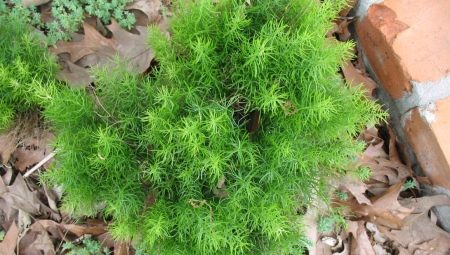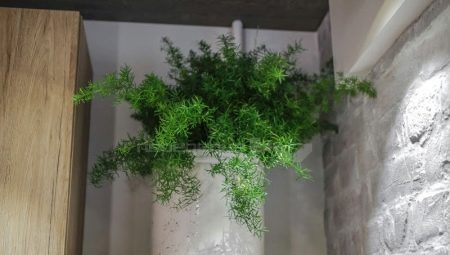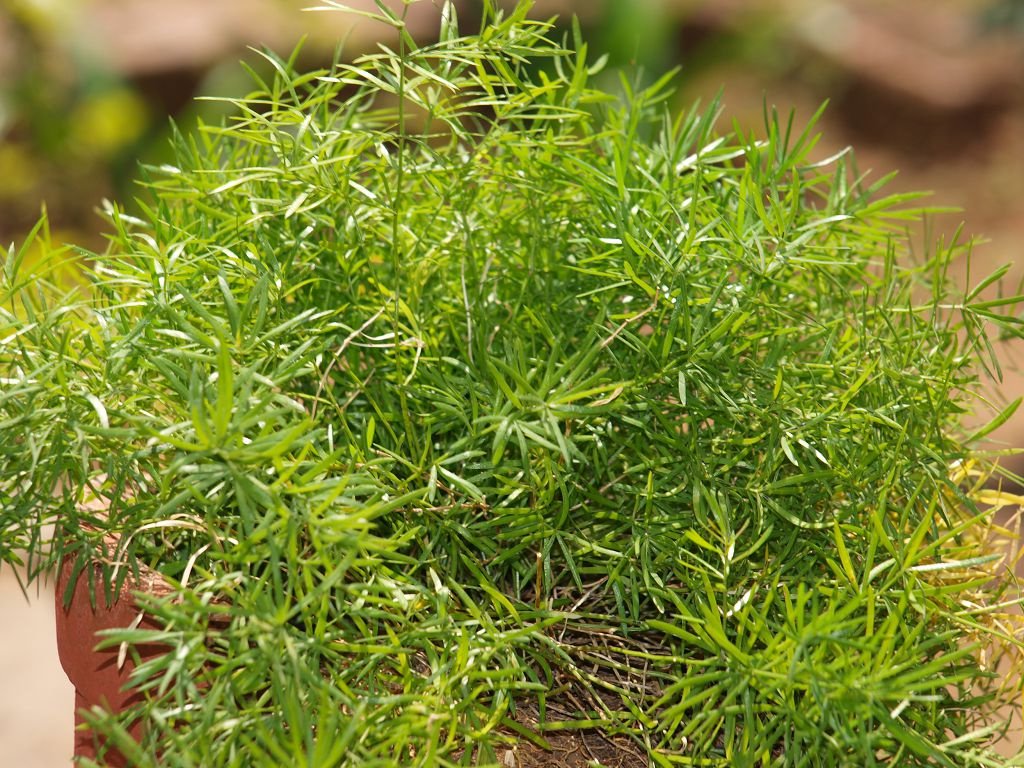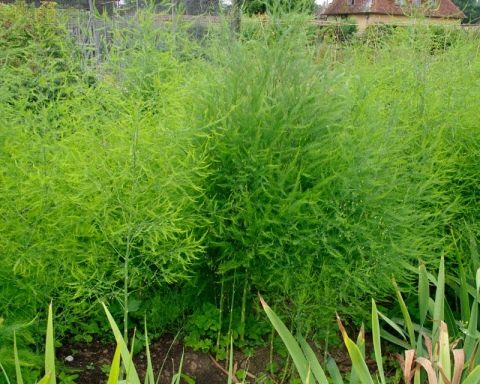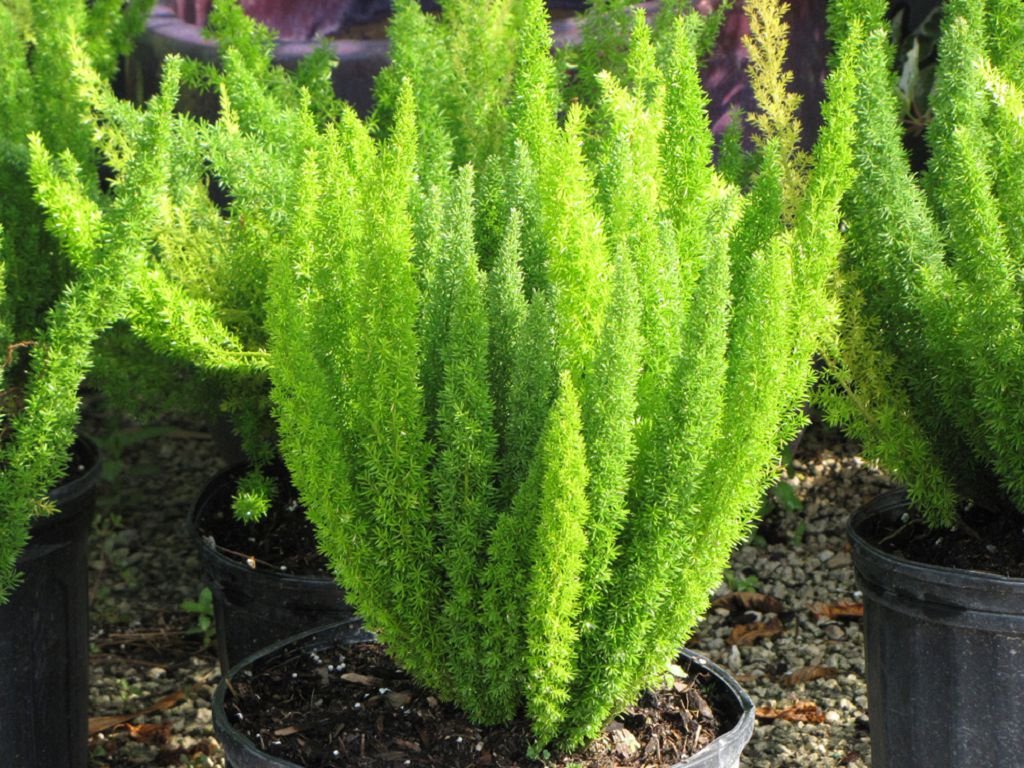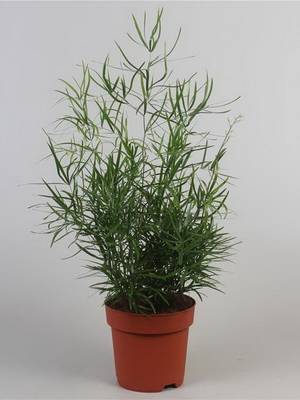Home content
To create optimal conditions for asparagus, you need to know some of the nuances:
- Temperature - in summer should not exceed +24 degrees, the plant loves fresh air. In winter, when the plant is at rest, the temperature is lowered to +15 degrees. It is difficult to create such conditions in an apartment, but since asparagus does not stick to one place, it can be moved as needed.
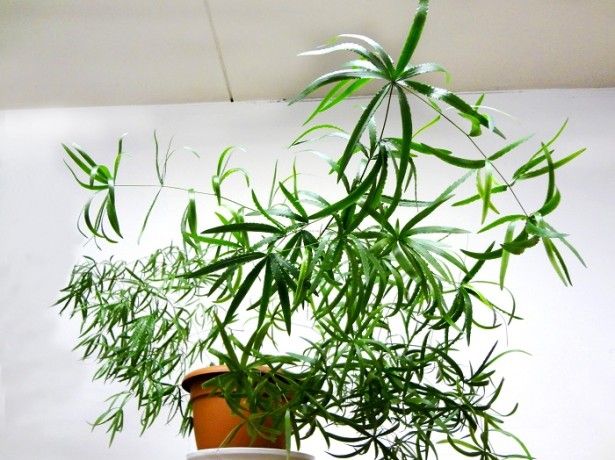
Lighting - Asparagus is very picky about light. If you put a flower on the north window, it will lose its decorative effect.
On the southern windows, the plant will receive sunburn, so the western or eastern windows will be the most optimal place in the apartment.
If it is impossible to create such conditions, then you should think about additional lighting - if the apartment is north, or cover the windows with curtains - if they face south.
Watering - Asparagus loves moisture, not only in the ground, but also in the air. If a plant can withstand uneven watering, then dry air is destructive for it. In winter, when the heating works, it is advisable to carry out the spraying procedure once every 2 days. But you can do it differently - put a cup of water next to it.
Top dressing. A newly transplanted plant does not need fertilization for the first 2 months. But as soon as the period of rapid growth begins from spring to autumn, it is worth regularly fertilizing deciduous plants. Asparagus responds well to organic inputs.
Pruning. Asparagus sickle tolerates a haircut well, unlike its counterparts. If you want a lush plant with small branches, feel free to arm yourself with scissors.
Transplant - carried out annually, since the root system of the plant develops very quickly. You need to handle asparagus in the spring.
Reference! The root system of the plant is very strong, and if the pots become too small, then under the pressure of the rhizome, it can burst.
Flowering care
If you are lucky enough to see asparagus flowers, then you should know that you can get fruits with seeds only if you artificially pollinate the flower. Otherwise, leaving remains the same.
What if it doesn't bloom? As mentioned earlier, a flower in an apartment may not bloom, and it is simply impossible to force it.
Possible growing problems and diseases
If you properly care for asparagus, then it practically does not cause trouble and does not get sick.
Drops buds and leaves
Falling leaves rarely disturb the asparagus, however, if a problem occurs, then the air in the room is not humid enough.
Leaves turn pale
The tarnishing of the bush is due to a lack of lighting and feeding. Depleted soil constantly needs to be nourished with minerals, especially during the growing season.
The tips of the leaves dry
Drying of the tips of the foliage occurs due to dry air and the appearance of some pests that suck the juices from the stems.
Note! It is necessary to constantly conduct a visual inspection of the bush for the presence of parasitic insects
The lower leaves fall
This problem is the most dangerous of all of the above; if left untreated, the bush may die. Lower leaves and shoots fall off due to over-watering and root rot.
Pests
Among the pests, the most common troubles are delivered by:
- spider mite;
- aphid;
- thrips.
It is necessary to treat the bushes with chemicals, but asparagus reacts negatively to some of them. Therefore, it is most effective to start treatment already at the first stages of the manifestation of pests.
On a note! It is useful to regularly rinse the bush under the shower.
Other problems
Asparagus often turns yellow, which indicates an increase in temperature and prolonged exposure to direct sunlight.
Historical facts about the asparagus flower
The earliest cultivated species can be attributed to the common asparagus, or as it is also called medicinal (asparagus officinalis) or pharmacy. It is popularly known as asparagus. Since ancient times, this dietary culture has enjoyed particular popularity among the peoples of France and England. However, long before that, it was grown in the territories of Egypt and the Mediterranean. There is an assumption that for the first time this flower was mentioned at the beginning of the flourishing of Egyptian civilization. This conclusion was made by archaeologists when they discovered the inscribed asparagus on a piece of a painted frieze, the time frame of which dates back to the third millennium BC. After some time, the famous culinary specialist of Ancient Rome mentioned this plant when writing his book about food "De re coquinaria".
The Romans had a special relationship to this plant, and therefore even during military campaigns they used it for food. In view of this, a certain fleet was even organized, the purpose of which was to deliver grass to the empire from the territory of the colonies.
Around 160 BC, Cato the Elder, a famous political figure of the time, wrote about asparagus as the most important culture for the empire.
 Asparagus asparagus
Asparagus asparagus
Difficulty caring for the plant
- With an excess of sunlight and the soil in the pot dries out, the leaves become covered with brown spots, turn yellow, and fall off.
- Too dry air, lack of lighting in the room lead to yellowing and shedding of foliage.
Improper watering can provoke root rot, up to the death of the plant.
Since asparagus needs space, it cannot stand being next to another house flower. Therefore, it is better to plant the plant in a hanging basket. Adult flowers sometimes need to make support for long shoots; supports can be made from threads or ropes. Direct long stems to grow along a window or wall.
To make vertical landscaping beautiful, systematically remove broken, weakened and old branches. The trimmed and pinched stems will begin to branch out.
Florists note that if a plant grows in one place for a long time, it develops much better and blooms more often. Therefore, try to grow asparagus in the same place.
Now you know how Sprenger's asparagus is grown and reproduced, as well as how he should be looked afterso that the plant grows well and blooms beautifully
The flower is easy to care for, it is only important for him to ensure proper watering. With timely feeding and pruning, you can get a beautiful, well-branching bush.
Asparagus care
Temperature: Moderate to cool, for most asparagus in summer, preferably no higher than 26 ° C. In winter, at least 10 ° C, ideally 12-14 ° C.
Lighting:Photophilous, the best place is the sill of the northeast or northwest window. If the plant is placed in a room, behind a tulle curtain, then its place is near the east or west window; if the window is south, then in the room at some distance from the window. In winter, more diffused light is needed, the plants are rearranged closer to the window.
Watering: In winter (from November to February), watering is moderate, in spring it is increased. In summer, you can leave water in the trays.
Air humidity: Loves humid air, sometimes asparagus does not bloom just because too dry air... If the plant is close to a central heating battery or fireplace, then small leaves begin to turn yellow and crumble, and spraying will not help here, you will have to rearrange the plant away from the hot air source.
Transfer: Asparagus requires spacious dishes and light nutritious soil from leafy, greenhouse and clay-soddy soil with sand. Young plants are transplanted annually in spring, old ones every 2-3 years.When transplanting, you should not damage the root system unnecessarily, but if the roots have grown very violently, then you need to carefully cut off the nodules with your hands, so that the root system decreases three times. During the period of active growth, fertilizing is carried out.
Stakhis in the country - planting, leaving
In the middle lane, stachis is grown as an annual - it does not form seeds. There are several cultivated forms of this plant, which are unpretentious, cold-resistant and feel great outdoors in our latitudes. And this is not to mention the fact that stachis can be perfectly cultivated in an apartment as an indoor plant.
Growing stachis in a summer cottage is a simple matter. The plant is undemanding to soils - it can grow on any, except overly acidic and waterlogged. It will prefer a flat, dry place, protected from direct sunlight.
The most convenient way to reproduce is by nodules. Since the plant is not afraid of the cold, they can be planted either at the end of April or at the end of September.
The plant is cold-resistant, the nodules remain viable in the soil even in very severe frosts. Therefore, no special shelter is required for the winter.
Cucumbers, tomatoes, bell peppers, eggplants, onions, and garlic are good precursors for stachis. But it is not recommended to plant it in the place of potatoes or cabbage - plants may have common pests (scoops, wireworms).
Of course, the more cultivated the soil layer in the beds, the larger the tubers of the Chinese artichoke will be and the higher the yield, so the soil should be prepared in advance - to add humus or manure for digging, and later - complex mineral fertilizer.
Large tubers, previously soaked in a solution of potassium permanganate and dried, are placed on the garden bed according to the scheme of 30 cm between future plants and 40 cm between rows to a depth of about 6-9 cm (depending on soil density). After planting, the soil must be leveled with a rake.
Stachis shoots will have to wait 2-3 weeks. Plants need to be regularly watered, loosened aisles, if desired or on poor soils, once fed with mineral fertilizers (20-25 g per 1 sq. very shallow, but at a distance from the main stem!), so that more nodules form on the underground stolon stems.
The main underground mass is formed in August-September, therefore stachis is usually harvested in early October.
The bushes are dug in with a pitchfork and the tubers are collected - attention, they "creep" far from the central stem, so it is quite difficult to harvest the entire crop. In appearance, the tubers look like twisted beige seashells with a distinct mother-of-pearl tint, for which the plant got its popular name
The more fertile the soil, the darker the shade of the nodules will be.
Stachis intended for quick consumption is stored in plastic bags in the refrigerator; for long-term storage, the nodules are placed in boxes with dry sand and placed in a cellar at a temperature of 0-3 ° C and a humidity of about 90%.
If there is not enough space, stachis tubers can be “stored” until spring just in the garden - without digging them out of the soil in autumn. Overwintered tubers in spring give shoots that can be transplanted with the roots, using as seedlings.
With long-term cultivation, stachis can grow on the site for 5-6 years without reducing the yield.
Planting and caring for Chlidanthus
Many gardeners do not like to deal with chlidanthus, despite its beauty. The fact is that chlidanthus is very whimsical and requires careful care and increased attention. The plant is not frost-resistant, despite the fact that in nature it grows in a mountainous climate. Rather, on the contrary - chlidanthus feels more comfortable on the windowsill in the apartment than in the open field.In the fresh air, chlidanthus may not even release flower stalks, so the plant will be more correctly grown in flower pots at room temperature. You don't need to water too often. If you notice that the base of the stem has changed color to dark brown, then this indicates an excess of moisture. Watering should be stopped for a while.
Chlidanthus can be planted in open ground already during flowering. But it should be remembered that excessive humidity, temperature changes can negatively affect the "well-being" of this plant. Even at a temperature of -5 ° C, a guest from Latin America can die.

Diseases and pests of asparagus
Asparagus does not grow after cutting. This is fine. Some time must pass and new shoots will grow, and those that were shortened will no longer grow - this is a feature of asparagus.
Spots on asparagus leaves. Asparagus does not like direct sunlight, and leaf spots can be burns. Also, the edges of the leaves may turn yellow, and the leaves themselves may fall off.
Asparagus leaves fall. If the cause is not a burn, then most likely this is due to too low humidity in the room. If the plant does not have enough light, the leaves can also crumble.
Asparagus pests. A frequent visitor is a spider mite. By the way, asparagus reacts extremely badly to insecticide treatment, so try to notice the pest in the early stages and do without chemicals.








